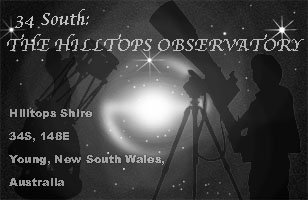I've been offering "daytime" polar alignment in my
app Polar Scope Align Pro for iOS. Users have been using it a night when they have no alternative, with varying results given how sensitive phone magnetometers are to local interference. I thought that I could offer users an option to compensate for interference with an extra calibration step, so the current beta version of the
app being tested has a new tool (tentatively) called "Laser / Hop Alignment", intended for people who have a polar scope, but can't view the polar star (Polaris obstructed, or σ Oct too faint etc), or people who only have a Laser pointer for alignment (e.g. for the MSM rotator), and it works a bit like this:
- You start with the phone mounted on the telescope (while it's pointing at
Dec 90), or the saddle directly so that its top is pointing where the
RA axis is pointing - no real precision is required for this as long as the phone is not moved during the process. You open the tool and first you get a list of suggested bright stars over your horizon that are not too far off the celestial pole (also a button to use any star up to Mag 5.0), and you choose one that you can see.
- Then, you move your mount in alt/az (even move tripod if the star is far away) and put the star you selected in the center of your polar scope, or as the target of your Laser. The
app will try to guide you, but it can be ignored at this step as it is uncalibrated.
- After pressing "Calibrate" the
app will know how much your magnetometer is off by using the reference "hop" star and will compensate for that, guiding you to the Celestial Pole.
The
app already has a Push-To tool for Dobsonians and when using an interim "hop" to calibrate the magnetometer, it gets you within 30 arcsecs of the target even with metal parts nearby, so I am expecting the polar alignment to also benefit.
Apologies for not being able to support Android, but if any iOS users want to try out this beta, you can just PM me with your email.
Polar Scope Align for iOS &
Xasteria Astro Weather Forecast:
astro.ecuadors.net
OTAs: SW Equinox 80ED, 200P-DS, 130P-DS, Evostar 90, Celestron C9.25, TS 70
Mounts: iOptron CEM25P, SW HEQ5 Pro
FR/FF: SW 0.9x, TSFlat2, Meade f3.3, Celestron f6.3, TRF-2008
Filters: Orion Imaging, Ha 12nm, S-II, CLS-CCD, OIII
Cameras: Canon 800D mod, 550D, ZWO ASI290MM
Lenses: Canon 15-85/3.5, Tair-3S, Tak 55/1.8, Jupiter 21M, 37A




